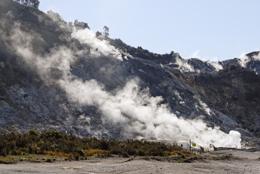20 September 2010 | Nature | doi:10.1038/news.2010.481
Volcano borehole prompts safety doubts
A drilling study could help defend Naples from an eruption, but critics call it risky.
 Drilling into the Campi Flegrei near Naples could help scientists to predict the next eruption.photolibrary.com
Drilling into the Campi Flegrei near Naples could help scientists to predict the next eruption.photolibrary.comDrilling deep into the heart of an active volcano might sound dangerous, but a team of scientists say that it could prove vital to protecting the Italian city of Naples from a potentially devastating eruption.
Early next month, researchers will begin to sample rocks and install underground sensors inside Campi Flegrei, a giant volcanic formation in southern Italy. They hope to learn where the magma is stored and what signs might precede an eruption. Campi Flegrei last erupted in 1538, and the ground in the area has been swelling for the past 40 years, leading to fears of another eruption within decades.
But critics say that the project is taking place too close to Naples and could lead to pollution, earthquakes or an explosion. The selected location "makes no sense", says Benedetto de Vivo, a professor of geochemistry at the University of Naples.
Campi Flegrei is thought to have formed 39,000 years ago, when a major eruption caused the ground to collapse in a 13-kilometre-wide area above a chamber of magma. The resultant bowl-shaped depression, known as a caldera, extends along the shore of the Gulf of Naples and is the site of a large number of craters and steaming fissures on land.
Scientists estimate that magma lies at least 7,000 metres below the surface of the caldera, but little is else is known about Campi Flegrei, or similar volcanoes. "Calderas are the only volcanoes that can cause truly catastrophic eruptions with global consequences, yet they are still poorly understood," says Giuseppe De Natale, the project's coordinator and a geophysicist at Italy's National Institute for Geophysics and Volcanology in Naples.
Deep heat
To learn more about the volcano, researchers are planning to drill a well in Bagnoli, a former industrial area near Naples and on the eastern part of the caldera. In the pilot phase of the project, starting in early October, De Natale's team will aim to reach a depth of 500 metres. The next phase, in which they will drill a 4,000-metre well at the same site, is to begin in spring 2011.
By measuring how the temperature of the rocks increases with depth, researchers hope to locate the centre of the magma more precisely. Borehole fibre-optic sensors measuring seismic activity, temperature and ground deformation will be installed and connected to above-ground stations, to regularly monitor the caldera's activity.
Probing 4,000 metres into an active volcano is no mean feat: temperatures are expected to be as high as 500–600 °C. "No similar project has ever faced such temperatures," says De Natale. The researchers will use a drilling rig provided by the International Continental Scientific Drilling Program (ICDP), an intergovernmental research consortium that is funding the project in collaboration with the European Union, the German Science Foundation and the government of the Campania region of Italy, in which the caldera lies.
Such a high temperature at a relatively shallow depth may turn out to be an opportunity for other research fields. Below 3,000 metres, researchers expect to find supercritical fluids, which form when water is above boiling temperature but under so much pressure that it can't turn into vapour. "Although the technology is still experimental, such fluids could one day be extracted and used in a geothermal plant, with a tenfold increase in efficiency compared to classic geothermy," says De Natale.
Quake danger
But the project comes with risks, says de Vivo. A similar project in Iceland, also sponsored by the ICDP, was halted last year after it unexpectedly found magma at a depth of just 2,100 metres. Hitting magma so close to the surface could theoretically cause an explosion in the well or trigger small earthquakes, which could be dangerous near a big city. He adds that drilling may repollute the old industrial site by bringing heavy metals and other toxic compounds to the surface.
De Vivo says that drilling closer to the centre of the Campi Flegrei caldera and farther away from Naples would provide more data, without risking the population of the city. "If the goal is studying the structure of the caldera, why drill so far from its centre, which is actually to the west, near the town of Pozzuoli?" he asks.
De Natale responds that drilling near Pozzuoli would be less interesting than at the proposed site, as it would allow researchers to study only collapsed layers of rock rather than a stratified picture of their chemical composition and temperature. He also rules out the possibility of hitting a chamber of magma. "If there was magma at such shallow depths we would know, because it would cause stronger surface activity," he says. "The fact that we are so close to a big city requires attention, but it is exactly why we want to know how the volcano will evolve over the next decades."
Source
--
Got Penguins?
Penguin News Today
The Science of Penguins
Gentoo Penguins of Gars O'Higgins Station, Antarctica
>^,,^<
__._,_.___
No comments:
Post a Comment